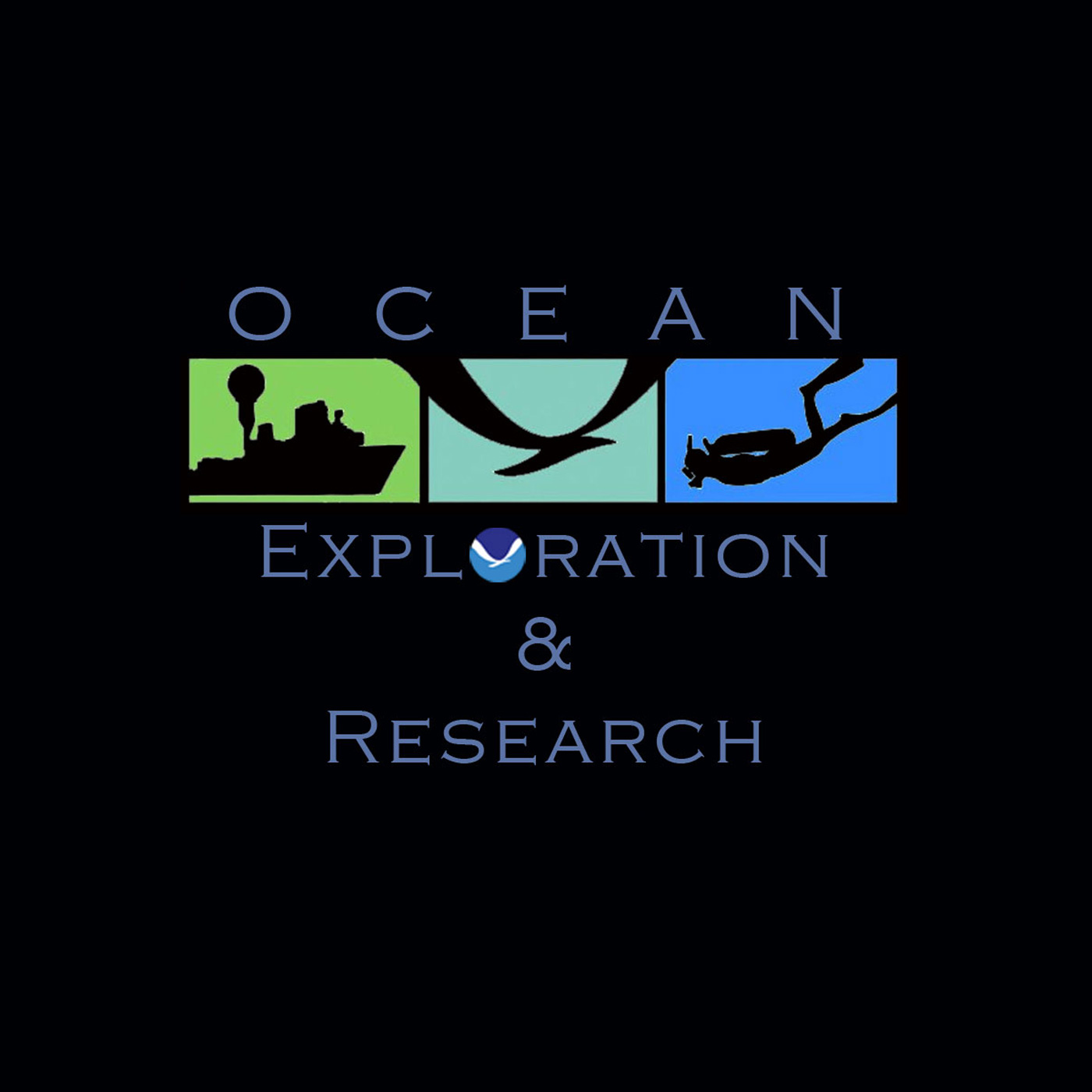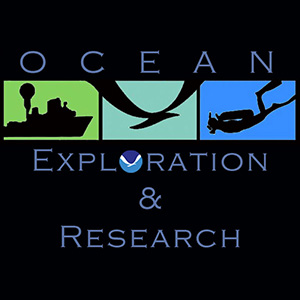Discover NOAA Ocean Explorer Podcast
NOAA Ocean Explorer Podcast

NOAA Ocean Explorer Podcast
Author: oceanexplorer.noaa.gov
Subscribed: 669Played: 12,394Subscribe
Share
℗ & © 2011 NOAA, Ocean Explorer
Description
NOAA Ocean Explorer is a website for all who wish to learn about, discover, and virtually explore the ocean realm. It provides public access to current information on ocean explorations and activities. Site visitors can follow explorations in near real-time, learn about exploration technologies, and observe remote marine flora and fauna in the colorful multimedia gallery. While we are not current adding content to iTunes, you can find us at http://oceanexplorer.noaa.gov or on YouTube at http://www.youtube.com/oceanexplorergov.
20 Episodes
Reverse
Throughout the course of the second leg of the Okeanos Explorer Northeast U.S. Canyons 2013 Expedition, scientists on the ship and on shore, along with the remotely operated vehicle (ROV) team and ship's crew, were joined by thousands of online viewers as we all explored canyons and intercanyons and Mytilus Seamount along the northeastern coast of the United States. This video captures highlights from the 15 dives that were conducted during Leg 2 of the expedition from the ROV Deep Discoverer and the Seirios camera platform.
Listen to a NOAA video podcast about the NOAA Ship Okeanos Explorer's Continuous Plankton Tow from Guam to California and sampling work conducted through the 'Pacific Garbage Patch'. Learn why systematic exploration aboard the NOAA Ship Okeanos Explorer is an evolving operational model referred to as a 'sticks and boxes' approach. The variety of data being collected onboard the Okeanos during this cruise from Hawaii to California represents a step forward in the exploration that can be conducted with the at-sea time allotted to the ship. Video courtesy of NOAA Okeanos Explorer Program, INDEX-SATAL 2010.
A compilation of video clips collected in deepwater by the Little Hercules Remotely Operated Vehicle and camera platform during an ROV shakedown cruise aboard NOAA Ship Okeanos Explorer offshore Kona, Hawaii (March 2010). The video footage shows a pelagic sea cucumber (apodid holothurian), Venus flytrap sea anemone (actinoscyphiid sea anemone), tipod fish (chlorophthalmid tipod fish), flatfish (pleuronectiform flatfish), eel (bongrid conger eel), shrimp (benthic caridean likely nematocarcinid shrimp), actiniid Bolocera-like sea anemone with a galatheid crab, Glass sponge and demospongid with hermit crab, and hexactinellid (glass) sponge next to a primnoid coral. Video Credit: NOAA Office of Ocean Exploration and Research.
Mendocino Ridge 4,600ft gas plume discovery off the California coast. Okeanos Explorer, "America's Ship for Ocean Exploration", is equipped with the latest in technology systems, including multibeam sonar. This technology involves sending beams of sonar to the ocean floor and measuring the amount of time it takes for those beams to bounce back to the ship. In doing so, the sonar creates a 3-D "sound picture", or map, of the seafloor. While the ship was testing its sonar off the coast of California, the sound waves bounced off gas in the water column, creating a remarkable image of a gas plume that rose 4,600 feet from the seafloor. A landslide area at the base of the plume has led some scientists to believe that the plume might be methane, released by the landslide from methane hydrates. Okeanos Explorer is preparing to explore the waters north of Indonesia in the summer of 2010, in collaboration with Indonesia. The ship will continue to explore the western Pacific in 2011. Video Credit: NOAA Office of Ocean Exploration and Research.
Scientists funded by NOAA and the National Science Foundation recorded the deepest erupting volcano yet discovered, describing high-definition video of the undersea eruption as spectacular. Eruption of the West Mata volcano, discovered in May 2009, occurred nearly 4,000 feet below the surface of the Pacific Ocean, in an area bounded by Fiji, Tonga and Samoa.
We found a type of lava never before seen erupting from an active volcano, and for the first time observed molten lava flowing across the deep-ocean seafloor, said the missions Chief Scientist Joseph Resing, a chemical oceanographer at the University of Washington who collaborates with NOAA through the Joint Institute for the Study of the Atmosphere and Ocean. Though NOAA and partners discovered a much shallower eruption in 2004 in the Mariana Arc, the deeper we get, the closer the eruption is to those that formed most of the oceanic crust.
This spectacular sequence is a close view of the eruption with violent magma degassing events producing bright flashes of hot magma. Lava is blown up into the water before settling back to the seafloor, and large plugs of lava flow rapidly down the slope. In the foreground is the front of the Jason remotely-operated vehicle (ROV) with sampling hoses. The area in view is about 6-10 feet across in an eruptive area approximately 100 yards that runs along the summit. Video courtesy of National Science Foundation and National Oceanic and Atmospheric Administration (NOAA).
Watch a NOAA video podcast on the NOAA ship Okeanos Explorer, "America's Ship for Ocean Exploration," commissioned in Seattle, WA August 13th, 2008 the ship and crew will undergo field tests off the U.S. West Coast to train operators and test concepts of operations and equipment associated with the ship and its sensors and systems. All this leads to the ship's first full field season of operations in 2009, and a new way of exploring the ocean.
Listen to a NOAA video podcast on the The NOAA ship Okeanos Explorer, "America's Ship for Ocean Exploration," commissioned in Seattle, WA August 13th, 2008 the ship and crew will undergo field tests off the U.S. West Coast to train operators and test concepts of operations and equipment associated with the ship and its sensors and systems. All this leads to the ship's first full field season of operations in 2009, and a new way of exploring the ocean.
Watch a NOAA video podcast on the AUVfest 2008 expedition that will take place in Rhode Island’s Narragansett Bay from May 12 through May 23. The event is a demonstration of 13 AUV systems originally developed by the Office of Naval Research (ONR) for mine hunting. As part of a collaborative effort to examine and evaluate the dual use of this technology, eight of these AUVs, and their associated sensors and systems, will also be sent on archaeological missions to shipwreck sites in Narragansett Bay.
Listen to a NOAA podcast on the AUVfest 2008 expedition that will take place in Rhode Island’s Narragansett Bay from May 12 through May 23. The event is a demonstration of 13 AUV systems originally developed by the Office of Naval Research (ONR) for mine hunting. As part of a collaborative effort to examine and evaluate the dual use of this technology, eight of these AUVs, and their associated sensors and systems, will also be sent on archaeological missions to shipwreck sites in Narragansett Bay.
Breathtaking... Nearly 20 years after first finding the sunken remains of the R.M.S. Titanic, marine explorer Robert Ballard returned in June 2004 helped by the National Oceanic and Atmospheric Administration (NOAA), Office of Ocean Exploration to study the ship's rapid deterioration. The team worked aboard the NOAA Ship Ronald H. Brown from May 30 through June 9 spending 11 days at the wreck site, mapping the ship and conducting scientific analysis of its deterioration. Using the Institute for Exploration (IFE) remotely operated vehicles (ROV's) Hercules and Argus, to conduct a sophisticated documentation of the state of Titanic was not possible in the 1980's. This "Look, don't touch" mission utilized high-definition video and stereoscopic still images to provide an updated assessment of the wreck site at an enormous depth of 3,840 meters (12,600 feet). As the nation's ocean agency, NOAA has a vested interest in the scientific and cultural aspects of the Titanic, and in its appropriate treatment and preservation. NOAA's focus is to build a baseline of scientific information from which we can measure the shipwreck's processes and deterioration, and then apply the knowledge we gain to other deep-water shipwrecks and submerged cultural resources. Video courtesy of the R.M.S. Titanic Expedition Team 2004, ROI, IFE, NOAA-OE.
This 2007 expedition will begin in the port of Manila and take us south through the Sulu Sea to our study site, southeast of the Sulu Archipelago, where the bottom falls off abruptly to the sea floor thousands of meters below. Lying just north of the equator, the Celebes Sea is the center of the most biologically diverse area of the world’s ocean.
Watch a NOAA video podcast on the Submarine Ring of Fire 2004 (SRoF'04) expedition to the Mariana Arc. This movie shows the discovery of the Champagne vent at northwest Eifuku volcano, where bubbles of liquid carbon dioxide are actively venting from sea-floor hot springs. This unusual phenomenon is due to the fact that the emissions from NW Eifuku volcano are particularly gas-rich. The high pressure at this depth keeps the carbon dioxide in a liquid state. Scientist discovered th Champagne vent at a depth of 1,607 meters (5272 feet more than 1 mile deep). Video courtesy of Submarine Ring of Fire 2004 Exploration, NOAA Vents Program, NOAA-OE.
Experience what it is like to be a Twilight Zone technical diver studying the biodiversity of creatures living in the Caribbean Sea between Cuba and Jamaica. Little Cayman has some of the steepest drop-offs in the Caribbean because it is perched on the edge of the abyss of the Cayman Trench 7500 meters below the crystal-clear surface waters. Video footage courtesy of Marc Slattery, Cayman Islands Twilight Zone 2007 Exploration, NOAA-OE.
This 2007 expedition to the Cayman Islands will set new benchmarks in ocean exploration technical diving research. Remarkable advances in this technology will allow for divers to share the excitement of the rarely explored Twilight Zone discoveries in a much more personal way. Video footage courtesy of Shawn Harper, The Hidden Ocean, Arctic 2005 Exploration, NOAA-OE.
This 2007 expedition to the Cayman Islands will set new benchmarks in ocean exploration technical diving research. Remarkable advances in this technology will allow for divers to share the excitement of the rarely explored Twilight Zone discoveries in a much more personal way. Video footage courtesy of Shawn Harper, The Hidden Ocean, Arctic 2005 Exploration, NOAA-OE.
In the frigid waters off the coast of Greenland scientists are getting valuable data from narwhals - the most ice loving whales in the world. Narwhals, beluga and bowhead whales, which you can hear in the background, make their homes in the Arctic. There are about 100,000 narwhals in the world, and the vast majority of them - about 50,000 to 70,000 - live in the Arctic waters of Greenland. Audio courtesy of Tracking Narwhals in Greenland 2006-2007, Kristin Laidre, NOAA-OE.
While much of under-ice diving is similar to regular diving, there are a few important differences. First, the divers wear drysuits instead of wetsuits. These dry suits are sealed at the wrist and the neck and don't let any water in beyond the seals. Second, under-ice diving is usually performed using compressed air, not other mixed gases and the regulators used are specifically designed to be used in temperatures below freezing. Most different from regular diving operations, under-ice divers are tethered to the surface. Video footage courtesy of Shawn Harper, The Hidden Ocean, Arctic 2005 Exploration, NOAA-OE.
Watch a NOAA video podcast on the deep-sea cold water corals located and sampled from poorly studied middle slope (360-800 meter) coral banks, from Cape Lookout, NC to southeastern FL covering over 650 nautical miles (1,205 km). Video courtesy of Ross et al, NOAA-OE, HBOI and Art Howard.
Listen to a NOAA podcast on the Submarine Ring of Fire 2006 (SRoF'06) expedition that will take place on the Mariana Arc, the third Ocean Explorer expedition to the Marianas. Audio courtesy of Submarine Ring of Fire 2006 Exploration, NOAA Vents Program, NOAA-OE.
Listen to a NOAA podcast on the GalAPAGoS: Where Ridge Meets Hotspot expedition, where scientists for the first time found black chimney smokers and explored undersea volcanoes. Audio courtesy of UCSB, Univ. S. Carolina, NOAA, WHOI.








🔴✅📺📱💻ALL>Movies>WATCH>ᗪOᗯᑎᒪOᗩᗪ>LINK>👉https://co.fastmovies.org